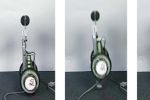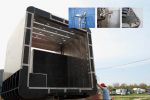Middleweight Camera Championship
Size is an issue with cameras. I miss a lot of good shots when I don’t feel like lugging around a hefty SLR (such as my current fav, the Nikon D90). And while my pocket camera (presently a Canon SD800) is easy to tote, the image quality is more for “snapshots” than “photographs.”
I, and a few other shutterbugs around the Popular Science office, have been looking into the middle category of cameras: big enough to take good pictures, but not so big that it’s a burden. Now is a good time to look, since several camera makers have fresh midsize camera offerings.
Recently introduced, the Canon G10 is the latest in its long-running series of “serious” point-and-shoots. At the heart of the camera is a tiny (about 40 square millimeters) image sensor similar to what you get in a pocket model. But it’s paired with a large, relatively bright (f/2.8-f/4.5 aperture) lens and sophisticated manual controls, all wrapped in a tough magnesium-alloy body.
Panasonic approaches from the other extreme. Instead of beefing up a point-and-shoot, it slims down an SLR. The Panasonic G1 is the first camera using a new format, perplexingly named “Micro Four-Thirds” (don’t ask), that provides the same large image sensor (225 square millimeters) and interchangeable lenses of an SLR but saves space by taking out the mirrors that allow you to see “through the lens” when you look into the viewfinder. The format has the potential to produce really tiny SLR-like cameras, but the G1 is just about the size of my third pick, an actual SLR (albeit the smallest ever), the Olympus E-420 which debuted last spring.
I took all three cameras out for both casual shoots around town and formal side-by-side tests. I had expected one to emerge as a clear winner. But it wasn’t that simple. Each has weaknesses that are either inconsequential or deal breakers, depending on how you intend to shoot.
Turn the page for a closer look at each model’s strengths and weaknesses.
Popular Tags
Regular Features

Featured
Gear & Gadgets
The MegaGoods Roundup
Our biggest collection yet: over 200 of the year's best gadgets, goods and gizmosBattle of the Ultra-Mobile Linux Laptops: Cloudbook vs. EeePC vs. My Old Thinkpad
How much portable Linux goodness can you get for $400?
Popular on Popsci
Most Viewed
Most Commented
Gear & Gadgets
- Skype and Mobiles No Match for the Landline
- Blow off traffic... literally
- Control iTunes with the wave of a hand!
- Kogan to launch Australia's first Android based mobile
- SLR Battle Royale
- The Amazing Lego Mac Pro and More
- Middleweight Camera Championship
- Middleweight Camera Championship
- Headphones Tailored to Your Hearing
- Nokia’s Own Jesusphone
Most Emailed
Gear & Gadgets
- Skype and Mobiles No Match for the Landline
- Blow off traffic... literally
- Control iTunes with the wave of a hand!
- Kogan to launch Australia's first Android based mobile
- SLR Battle Royale
- The Amazing Lego Mac Pro and More
- Middleweight Camera Championship
- Middleweight Camera Championship
- Headphones Tailored to Your Hearing
- Nokia’s Own Jesusphone








